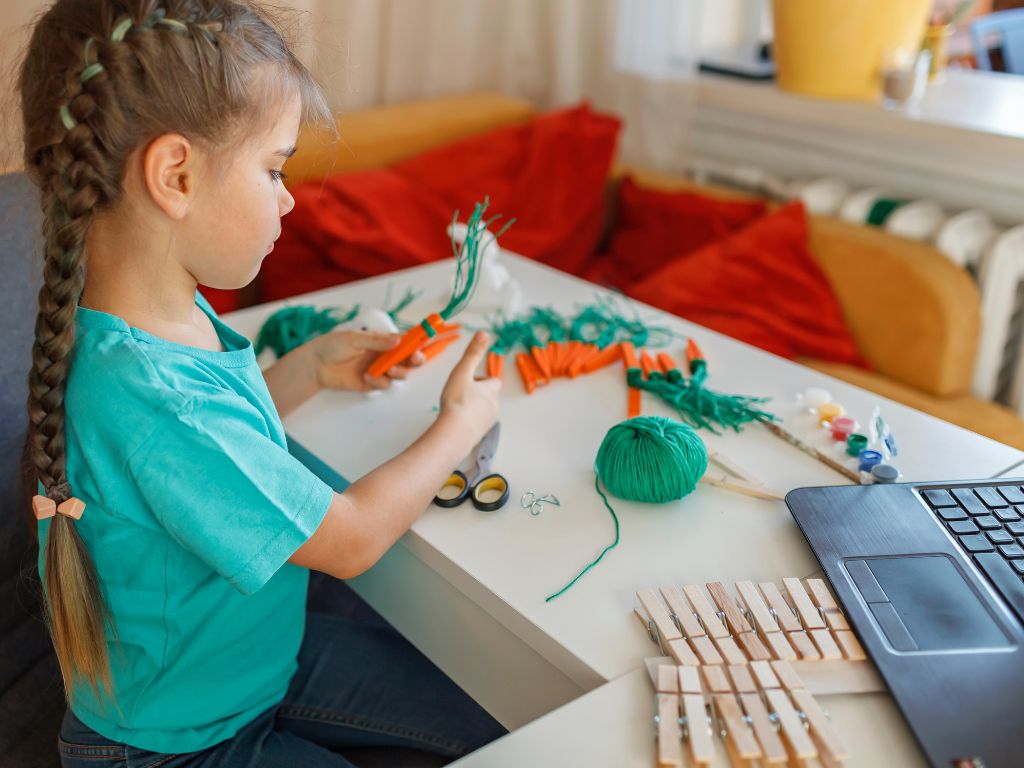Disclosure: This page may contain affiliate links. The Tutor Resource is a participant in the Amazon Services LLC Associates Program as well as other affiliate programs. These are designed to provide a means for us to earn fees by linking to Amazon and affiliated sites at no extra cost to you. Please see our full disclosure for more details.
How to Write Awesome Outschool Lesson Plans
Are you an Outschool teacher looking for creative and engaging Outschool lesson plans? Look no further!
At the Tutor Resource, we have several curriculums and curriculum creators who work with Outschool. So we’ve gotten to know the ins and outs of Outschool lesson plans pretty well!
If you want to know how to create Outschool lesson plans that get approved quickly, are engaging for the student, and meet the parent’s objectives for your Outschool classroom, then you’ve come to the right place.
In this blog post, we give you some tips on how to write awesome Outschool lesson plans for any topic. By following these simple tips, you’ll be sure to create lessons that your students will be sure to remember!
Components of Outschool Lesson Plans
Haven’t heard of Outschool before? Well, Outschool is a community marketplace of online classes for kids.
They provide a platform for teachers to organize, promote, and deliver online classes. Teachers choose what they want to teach, when to schedule their classes, how to write their own lesson plans, and how to price them.
The categories below will be in every Outschool lesson plan template on their site that you’ll need to complete when making your class proposal. If you tailor your creation strategy to include these items, you’ll be more likely to get it approved quickly.
✔️ Topic
Before you start, you will need to choose a topic for lesson planning. If you already have an inkling of what you would like to teach children, great! Maybe it’s something related to biology or ESL or animation.
Before you can figure out what you want your pupils to learn, you must first determine who you’re teaching.
We assure you that attempting to educate a class of 4-year-olds in trigonometry is not something that will be enjoyable for anyone (and bookings are unlikely).
However, if choosing a topic causes some stress, no worries at all! The Tutor Resource has plenty of Outschool class ideas to inspire you!
✔️ Lesson Title
The title of your lesson is the first thing prospective students and parents will see, so make sure it’s catchy and accurately reflects the content of your lesson. Use alliteration if you can.
If you’re stuck on a word, Google “A-Z lists of nouns and verbs.”
For example, a good title for a lesson on fractions might be “Fun with Fractions: Learning to Divide.”
✔️ Course Type
Outschool offers 3 types of courses:
👍 One-time courses are exactly what they sound like – they’re offered once and don’t recur.
👍 Recurring courses run on a regular schedule (e.g. every Tuesday at 4 pm) and are automatically enrolled, meaning students are automatically enrolled in the next session of the course as long as there is availability.
👍 Private courses are only open to a specific group of students – for example, if you’re teaching a course to a scout troop or after-school program.
✔️ Course Length
Outschool courses are 50 minutes long.
✔️ Group Size
We recommend keeping your class size to six students or fewer, although can choose any class size you like. This way, you can give each student the attention they need and create a more intimate learning environment.
Regardless, the number of students in the class should align with your desired outcomes, learning goals, and teaching style.
✔️ Age Range
Consider the course objectives for the grade levels you intend to offer. This might assist you in defining the age group (range) to include.
This site contains outcomes by subject and grade level in Canada. You can also refer to the US Common Core standards if that is more familiar to you.
✔️ Image and Video
This is optional but can help set the tone for your course. The image should be high quality and relevant to the title and content of your course. Parents will use an image to decide if they want to read more about it, so we strongly suggest making a good one.
If you’re going to use a video, make sure it’s less than two minutes long and that you have the legal right to use it. All videos must be hosted on YouTube.
Make sure the picture you want to use is correctly formatted before you go any further. If you’re using a camera, don’t shoot it in portrait mode; doing so will be more difficult to crop the photo. Follow Outschool’s standards and requirements if you have specific questions.

✔️ Course Description
Write an engaging and simple description of your course, using clear and concise language. Parents will use this description to decide if they want to enroll their child in your class, so make sure you sell it!
Here are some tips:
👍 Start with the title of your course and its purpose in one sentence. For example: “In this course, students will learn about fractions by playing games and working on projects.”
👍 The next sentence(s) should describe what the students will do in your class. Be specific and use active verbs. For example: “Each class, we will play a game to review what we learned in the previous class. Then we will work on a project, such as making a fraction collage.
👍 The last sentence(s) should describe the outcome of taking your course. For example: “By the end of this course, students will be confident in their ability to divide fractions and will have a better understanding of how fractions are used in everyday life.”
👍 Keep it short! A good course description is no more than four sentences.
✔️ Learning Goals
This is where it is important to be very specific. Use Bloom’s Taxonomy of Verbs to frame the learning goals as “Learners/students will be able to…”
By the end of this lesson, students will be able to share sources of ideas for artwork they have seen, experienced, or thought about.
They will have developed an understanding that artists can be influenced by their own or other cultures, and their own place or places they have been and/or learned about.
Students will be able to reflect that “place” can be more than physical location. Finally, students will have followed step-by-step instructions to create a painting of a face in the style of Picasso.
✔️ Homework
Be as specific as possible in your instructions/tasks/completions, as well as the anticipated length of time and resources/materials required.
Noting if or how much adult assistance is needed would also be beneficial. Make sure homework is consistent with learning objectives and outcomes, and it helps students expand what they’ve learned or helps them learn further.

✔️ Assessment
Keep in mind the differences in “assessment of learning” versus “assessment as learning.”
Consider how you will know if students are mastering the learning goals. This might be through questioning during class, written work, projects, or other means.
You might also want to give feedback on strengths and areas for improvement for each student, as well as provide an overall summary of how the class is progressing in relation to the learning goals.
✔️ Differentiation
Describe how you will differentiate instruction for students at different levels, including those with special needs.
This might involve providing different tasks for students to complete, giving more or less scaffolding, or varying the pace of the lesson.
✔️ Supply List
Before you begin a lesson, double check that everything a learner will need is included on the list. To make sure nothing has been forgotten, do a practice run of the lesson.
Also, send learners a welcome email with the supply list attached at least one day before the lesson starts even though all materials are listed online and in an Outschool email.
✔️ External Sources
Bring any external resources (printouts, web sites, books, etc.) that the student will require before, during, or after class.
This includes links to informative internet sites for those who wish to learn more about the subject material.
✔️ Classroom Management
Include a description of your general approach to classroom management, as well as any specific rules or procedures you have for your class.
This might include procedures for starting and ending class, raising hands, sharing ideas, or working in groups.
✔️ Time Commitment
By practicing the lesson, you can ensure that you have provided specific time commitments. The goal is to finish the class on-time (not early – parents are paying for the allotted amount of time; and not late – they may have other things scheduled).
Be explicit if there is extra work required outside of class in order to meet pre- or post-activity requirements. If there is, ensure you state approximately how much time you estimate will be needed.

✔️ Parental Guidance
Parents need to be made aware of any material or content that might require their assistance. This way, they can be prepared and available if needed.
Be as specific as possible in your disclaimer – even a general statement will suffice and be greatly appreciated.
Lesson Plan Example Wording: All materials and resources are suited to and appropriate for elementary-aged students.
Pro Tip: If you don’t want to create your own Outschool lesson plans, you can get them pre-made on the Tutor Resource!
10 Tips for Writing Outschool Lesson Plans
If this is your first time writing Outschool lesson plans or designing curriculum instruction, here are some tips to help you ensure high curriculum instruction quality!
1. Brainstorm
Start by brainstorming a list of topics you could teach. Consider your interests, experiences, and expertise when making your choices.
We have a huge list of Outschool class ideas for quality online teaching that can help you get started!
2. Narrow it Down
Once you have a list of potential topics, narrow it down to one or two that you would like to focus on. In addition, think about what age group(s) you would like to teach.
3. Research
Research your chosen topic to gain a better understanding of the content and determine the learning objectives you would like your students to achieve.
This means taking a look at multiple perspectives including existing lesson plans, articles, books, and other resources.
4. Start with the End in Mind
Keep the learning goals at the forefront when planning your lesson. Every activity and task should be directly related to and support the goals. This includes assessing student learning at the end of the lesson.
5. Keep it Simple
Don’t try to cram too much into one lesson. Stick to one or two main concepts and build from there. They can always be expanded upon in future lessons, or students can be given suggestions for further exploration on their own.
You could even take additional concepts and turn those into entirely different courses!

6. Make it Engaging
Students will be more likely to retain information if they are actively engaged in the lesson. Include a variety of activities and tasks to keep them interested.
For example, you could make lessons more fun by incorporating games, role-playing, discussions, hands-on activities, etc. Kids love to participate!
7. Check for Understanding
Throughout the lesson, check for understanding to make sure students are on track. This can be done through questioning, informal assessment, or other means. In addition, be sure to give students the opportunity to ask questions.
8. Be Prepared
Before the lesson, double-check that you have everything you need. This includes materials, external resources, and your own understanding of the content.
You don’t want to be caught off guard! It would not get you a good review to need to leave the camera during class time to get an item or two that you forgot to grab before the lesson begins!
9. Use Quality Learning Activities
Not all learning activities are created equal. Choose those that are most likely to engage and challenge your students.
Here are a few questions to answer before you can start thinking about learning activities for the class:
✔️ How old are the children you want to teach?
✔️ What will they need to know about the topic before you teach?
✔️ How many students can you teach at a time?
✔️ Will this be a one-time class or multiple class?
✔️ How long will each class be?
✔️ What will the students need to bring?
✔️ Will they need parental supervision?
10. Tie it All Together
At the end of the lesson, take a few minutes to summarize what was learned and accomplished. This will make your instruction quality online better as well as help solidify the content in students’ minds and give them a sense of closure.
Plus, it’s always nice to end on a positive note!
Pro Tip: If you want to make your Outschool lesson plans work for you when you aren’t teaching them, consider joining the Tutor Resource as a creator. You keep full control of all your materials and make some extra money at the same time!
Final Thoughts: Outschool Lesson Plans
Writing Outschool lesson plans can seem daunting at first, but it doesn’t have to be!
Just follow these tips and you’ll be well on your way to creating awesome and engaging lessons for your students. They’ll be sure to remember what they learned, and you’ll have a great time teaching them!
We hope you found these tips helpful. Happy teaching!
Are you seeking certification for teaching English?
If you are or want to be an online ESL tutor, then certification is required by many companies & desired by many private clients.
👉 We recommend this TEFL course! They even offer post-completion job support and resources.






